Spider-view: "Fathers and Sins"
This four-parter introduces a controversial story arc, sidelining some surprise for genuinely intriguing character development
—by Nathan on December 30, 2023—
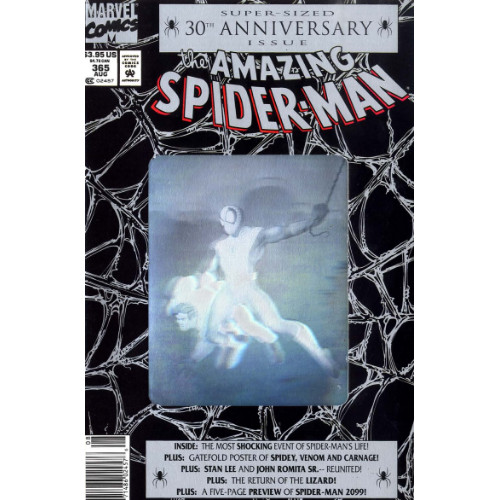
In 1992, Spidey turned 30 years old.
That's 30 in "publication years," not necessarily age. If we go by the suggestion that every four years in the real world equates to a single year in the Marvel Universe, then by 1992, Peter Parker had aged about seven years since he was originally bitten by the radioactive spider, putting him at around 22 or 23. The age is just an approximation, but the point is he wasn't 30 years old. But the idea of Spidey, the character of Spidey…that reached a three-decade milestone in 1992.
As the more specific 30-year anniversary of "August, 1992" came up (marking 30 years precisely from the publication of Amazing Fantasy #15 in August, 1962), it seems Marvel wanted to do something special to celebrate. This is an anniversary, after all, and if other milestones had been marked by such major events as the dissolution of the Peter Parker/Black Cat relationship or the introduction of Venom, why shouldn't this anniversary have a special event?
Good things never seem to happen in these issues, sadly. A relationship is broken, or a friend is thrown in jail, or Spidey is on the receiving end of a beatdown courtesy of Doctor Doom. The same theme kinda happens here, too.
We've always known Peter was an orphan. Aunt May and Uncle Ben were established as his non-biological parents in Peter's very first appearance. But it took until 1968 to answer the question of how Peter became an orphan. In Amazing Spider-Man Annual #5, Stan Lee and his brother Larry revealed the fate of Peter Parker's parents: they were American spies who died in the line of duty and were made to look like traitors. Peter, seeking to prove their innocence, got caught up in conflict with the Red Skull, learning Richard and Mary Parker were, in fact, double agents and their seeming defection was a plot to remain undercover.
And that was it. Peter cleared his parents' names and laid their reputations to rest. Case closed, shut the book on that one…
Except, this is comics. And very little, it seems, is laid to rest permanently.
"Fathers and Sins"
Writers: David Michelinie (main story); Stan Lee, Tom DeFalco, Peter Sanderson (back-up strips)
Pencilers: Mark Bagley, Jerry Bingham (main story); Aaron Lopresti, John Romita, Tod Smith (back-up strips)
Inkers: Randy Emberlin (main story); Aaron Lopestri, John Romita, Andrew Pepoy (back-up strips)
Colorists: Bob Sharen, Renée Witterstaetter (main story); Kevin Tinsley, Joe Rosas, Kevin Tinsley (back-up strips)
Letterers: Rick Parker, Joe Rosen (main story); Dave Sharpe, Chris Eliopoulos, Jon Babcock (back-up strips)
Issues: Amazing Spider-Man #364-367
Publication Dates: July-October 1992

The Parkers are back.
How's that for a 30th anniversary shock?
Pearls are often given to mark a 30th anniversary, symbolizing the love that has developed over the last three decades between a couple, the bond which has grown between two people. Spidey gets a couple celebratory hologram covers and the shock of his life when his parents are, suddenly, revealed to be alive. No pearls here–not much of a chance to celebrate a bond you never had the opportunity to forge because you thought those people were dead, right?
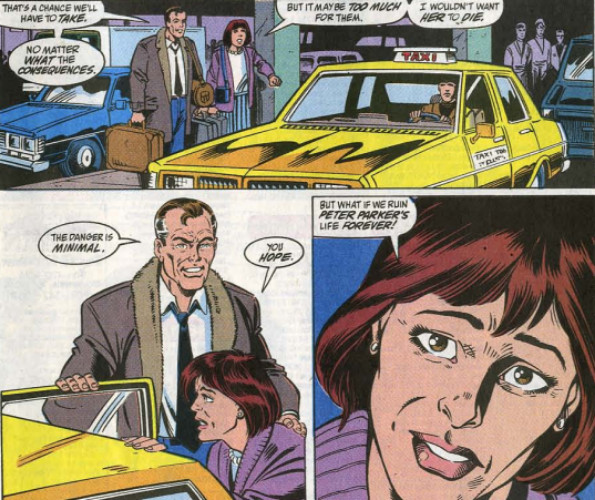
Going into this, I knew the full scope of the story. I knew where this revelation eventually leads. I'll be discussing that facet at the appropriate time, but with foresight, I find I'm judging this surprise turn of events differently than if I headed into this story blind. The whole bit is done fairly well by Michelinie–we've received no evidence from any prior story, such as Spidey’s first encounter with Carnage or his second conflict with Cardiac, that Richard and Mary will be popping back up. But Micheline doesn't need that. He introduces us to Richard and Mary, somewhat teasing us as to their identities, before confirming who they are at the end of the second part of this four-issue arc. Some may feel that Michelinie's plotting is rushed, throwing these two into the mix at this specific time; others may accuse him of placing shock over substance, using the twist the same way DC used the death of Superman in the 90s to generate sales or hype for various titles.
This may, again, be the benefit of hindsight speaking, but I don't mind how Michelinie delivers the news to us. In fact, I prefer the method over Micheline languishing over these characters, showing us who they are through panels or pages at a time across multiple issues. Yes, we're thrown into the thick of the plot rather quickly, but even the issue buffer we receive is beneficial. Michelinie develops tension in us–we know what Peter doesn't yet know as he battles the Shocker and the Lizard, two battles totally unrelated to the parent plot pot simmering in the background. I'm actually grateful Michelinie didn't tether these two conflicts directly to his narrative, as we see happening sometimes in comics. There's no coincidence here. Each plot is handled individually, with the "Peter's parents have been alive this whole time" piece dramatically tearing itself into Peter's life at the optimum moment, the halfway point. The scene is reminiscent of Mary Jane's introduction, Aunt May leading Peter into a situation where his life will change forever.
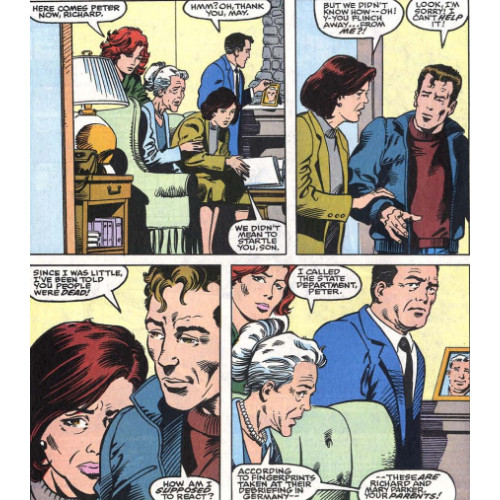
Michelinie derives nice tension from the development over the next two issues, and though "The Saga of Peter Parker's Parents" will continue for some time across the Spider-Man titles, the immediate reactions happen here. Peter is shaken–literally, he shakes–and behaves a little unlike himself; nicely, Michelinie keeps a moment where Peter, after leaving May rather brusquely, turns back to offer the woman he really considers "Mom" some affection. It's a notable response, showcasing the divide Peter feels between his flesh-and-blood parents and a woman who in every way but biologically is his mother. It's May who raised him in his parents' absence, May who's been with him through the ups and downs, given him pep talks, made him wheat cakes, been a supporting shoulder.
Little moments such as these allow Michelinie to play with various characters' emotions. Richard momentarily mourns the loss of his brother, Ben; May reflects on her own losses, including the death of fiancee Nathan Lubensky; MJ copes with the sudden news by turning back to smoking, a habit she battled around this time. Michelinie does well to remind us of the far-reaching impact of this shocking twist; the impact the return of Peter's parents has isn't just limited to Peter. Each moment is small, but they're present, fit well in-between scenes of Spidey playing detective as he digs into the truth behind his parents
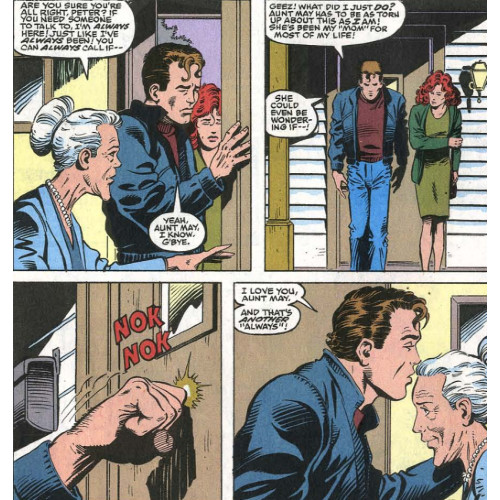
Michelinie even weaves in some nice theming prior to the Parkers' return. The Lizard battle is predicated on Curt Connors–more fully in control of his domineering personality after his run-in with Calypso–needing a DNA sample from his son Billy. Michelinie establishes conflict between father and son, with Billy taking a stand to rid his father of his serpentine side. The father/son dynamic between them, I wager, is to foreshadow Richard's return and the tension created between him and Peter. "You’re my dad! I love you!" Billy yells at his father at one point, and we get the sense that if Billy can deal with a leapin' Lizard for a parent, Peter can come to terms with his own father's bizarre circumstances.
The Shocker battle doesn't carry such thematic heft, but it is a nice nod to The Deadly Foes of Spider-Man, where the villain appeared as a rather frightened kitten in the face of a potential threat on his life. The inclusion of both the Lizard and Shocker are nice connections to recent continuity, reminding us even Spidey's villains have their own tangled histories.
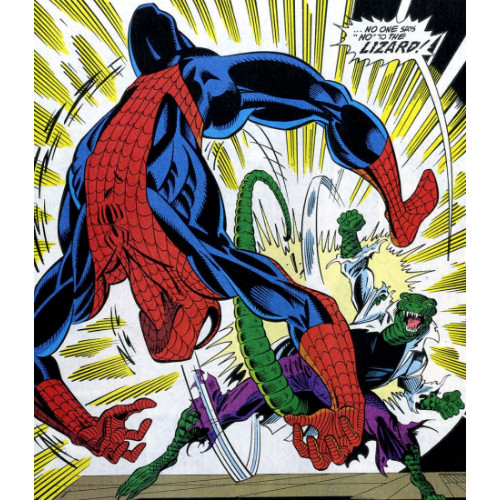
The super-duper special anniversary issue (ASM #365) includes a few back-up strips unrelated to the main plot, some of which were contributed by Stan Lee and John Romita. Two tales, told from the perspectives of J. Jonah Jameson and Mary Watson, respectively, serve as recaps of different eras of Spidey history. Jameson essentially takes credit for the creation of Spider-Man by overlaying his egocentric viewpoint over what he knows of the hero’s first appearance, and MJ reflects on Gwen Stacy and her relationship with Peter. Were these stories merely regurgitated to us, they'd lack any kind of connection–how many times have you read or seen Spidey's origin? But Spidey's origin told through JJJ's perspective? That makes for a wildly different reading experience.
The tones of each piece are radically different, with JJJ's self-serving attitude twisting facts in a humorous and ironic, if not somewhat frustrating, fashion, while MJ lovingly recounts her memories of her friend. The strips are decent attempts at celebrating important moments in Spidey history–his origin, the formation of his relationship with Gwen, her death–in a way that end up being more entertaining than I would have originally assumed, particularly compared with some "meh" back-up strips I've recently perused in Spidey annuals.
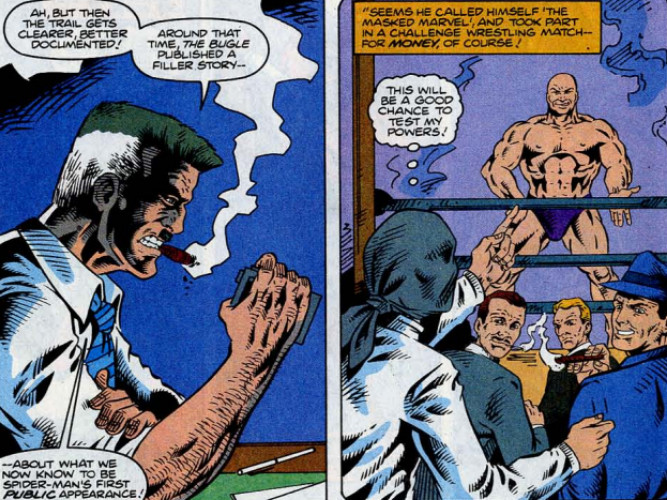
This four-parter hits us with a bombshell, promising to alter the trajectory of Peter's life in surprising ways. The Parkers will pop up in several upcoming "Spider-view" posts as their story is unpacked. Get ready for some more twists and turns, some which feel less substantial than they should. But it's the 90s, right? For every series about a madman snapping half the universe away comes the thread-by-thread un-spooling of a demigod's death and his resurrection not long after. Shock and awe are the icing on top of an increasingly grim, violent, dark cake. I've grown a little fonder of the decade, but I still may have my qualms. And as we maintain our momentum through the overarching saga of Peter's parents, especially as we draw closer to that looming edifice known as "The Clone Saga," we may find just how rampant writers and artists ran through material.
Yes, very little is laid to rest permanently in comics. But some bodies are better left in the ground.